

The Strength is set to 2.Īnd that is how you light something perfectly. In this example, a Hemi light is positioned above, to the left and behind the skull pointing forwards towards the camera. The rim or edge light is positioned behind the object pointing towards the object and the camera to highlight the edge of the object to separate it from its background. In this example, an Area light is positioned below the camera and to the left pointing up at the object. The fill light is positioned opposite to the key light to fill in any shadows. In this example we used a sun light above and to the right of the camera. This casts light on the front and top of the object and shadows on the surface over any undercuts. The key light is either a strong, sun-like light or spotlight shining on the front of the object being lit. The basic lighting setup taught by all photography courses is to have a key, fill and rim or edge light. To set an object to an emission surface, click on the Materials properties, click on the surface drop-down and select “Emission” from the drop-down. The only light sources in this scene are the objects themselves. The standard lights in Blender are invisible to the camera, but lights which are objects can be seen. You can turn objects into lights, the benefit being that you can see the lights. The light is soft and the shadows smooth. The texture emits light, meaning you can make a ball, cube or plane be a light emitter. Shadows are sharp when the objects are close to a surface but softer when they are distant.Īnother kind of light you can have in Blender is to turn an object into a light by selecting a surface texture of Emission.

Shadows are hard-edged.Īrea lights are flat planes which cast light like a softbox or light reflected from a large reflective surface. These lights are like spotlights, but the difference is the source is a half sphere and the light focusses in straight lines, like a lighting brolly. Shadows are hard-edged and follow the angle of the beam. Spotlights have a point source, but they fan out at a particular angle set in the properties, and they have a soft transition from the middle to the outer radius, the same as a real spotlight. Shadows cast straight down from the source and are soft. Sun lights emulate the light you get from the sun the light comes down from the source in parallel lines. Shadows fan out from the source centre in radiating lines. These lights are a tiny ball of light which are omnidirectional – that is to say scattering light in all directions like a lightbulb. The basic types of lamps in Blender are as follows: Point, Sun, Spot, Hemi and Area.
COPYING THE LIGHTING FROM A PHOTO BLENDER HOW TO
To get good lighting in 3D graphics images, you need to have a grasp of lighting in the real world, so a good tip is to learn how to light photographs from photography tutorials out there on the Internet. In the virtual world of a 3D program the lights are all computed rather than real, but they perform the same function as real world lights. But how can you use all the different kinds of lamp for something approaching real cinematography? Types of LampĬinematography is all about choosing the right lights. In previous articles we have discussed how you light a scene on a basic level.


 0 kommentar(er)
0 kommentar(er)
